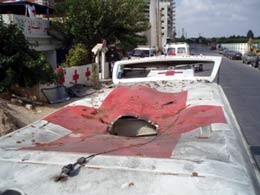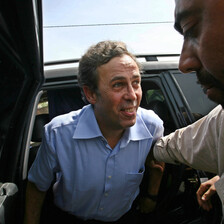Electronic Lebanon 31 August 2006

The targeted Red Cross vehicle (Dahr Jamail)
The centre of the hoax allegation is the 23 July attack by the IDF in southern Lebanon on two ambulances in which six people were injured - including one man who lost his leg in the attack. An unattributed right-wing blog, Zombietime.com, claimed that photographs of the incident had been faked. In particular, the blog seems incredulous that incoming fire could possibly pierce the dead centre of the red cross symbol on the roof of the ambulance.
Those behind this website and their motives are little known. But Downer gave the claims his unqualified support when he spoke on 28 August at a National Newspaper Publishers Conference. Ironically, as he stepped forward to berate the media for a lack of rigour, he was falling headlong into the same trap. Without any effort to check or verify the website or its sources, he claimed:
“What concerns me greatly is the evidence of dishonesty in the reporting out of Lebanon.” He went on to say that: “After closer study of the images of the damage to the ambulance, it is beyond serious dispute that this episode has all the makings of a hoax.”Writing in The Australian on 31 August, Middle East correspondent Martin Chulov describes for us his own proximity to the event. He demolishes the hoax claims with far more efficiency than the blog’s laborious 28 pages straining to suggest the incident was a hoax.
As Chulov describes:
“Late in the evening of July 23, Qassem Shalin, a volunteer member of the Lebanese Red Cross for 13 years, set off in his ambulance for a cross road near the village of Qana in southern Lebanon. His job that night was to collect, with a second ambulance, six people who had suffered minor injuries the day before during fighting between Hezbollah and Israel.The International Committee of the Red Cross has also rebuked Foreign Minister Downer. They say his assertion is baseless and that there is no evidence the media have been fooled concerning the Israeli attack on the ambulance.It was a call-out that almost cost Shalin his life and, according to Foreign Minister Alexander Downer, has since cost him his reputation as an impartial protector of war’s wounded.”
Downer, however, is unrepentant. He told ABC Radio’s AM program on 30 August that he based his assertion on photographs of the ambulance that showed little damage. He continued, “obviously if an ambulance had been hit with a missile it would have been blown to bits.”
But Martin Chulov found this reasoning to be incredulous, coming from a Minister and adviser (Tony Parkinson) close to military matters. As Chulov points out:
“The Israeli-made drones have many types of missiles, but the most regularly used has a small warhead designed for use in urban areas. It aims not to kill anyone outside a small zone and rarely leaves a calling card outside its target.Absurdity aside, Downer’s rash comments damage the credibility of his government. It’s not a good stance to make these claims until you see the company you keep. For example, does he also endorse other repellent claims such as the provocative one that the IDF bombing of Qana was a ‘Hezbollywood’ style fake? Bloggers are part of the ‘noise’ of the net. But for Downer to raise the hoax claims above this chatter and into the political arena is most unwise. For it might well be interpreted as an intervention designed to politically orchestrate such propaganda. If one, two or more incidents are alleged to be false, indulging in this war of images can only encourage a shameful scepticism over all such suffering.Downer and Parkinson should know this. The Australian Government last year signed a deal to buy drones from Israel. They would surely have come with a buyer’s guide.”
Suspicion remains that Downer’s statement might be less clumsy and more cynical than we imagine. Although a ceasefire is in place in Lebanon the war of words and images rages on. It is perhaps no coincidence that Downer chooses to raise the hoax claim at this time - even if he’s half expecting it to be shot down in flames. No matter. It is a diversion from damning evidence emerging about how Lebanese civilians are being mown down by unexploded shells and American-made cluster bombs supplied under undisclosed terms of use. The United Nations has accused Israel of the “completely immoral” use of cluster bombs. With Downer mocking media ethics, he may deflect scrutiny away from the morality of the US arms trade and its death toll.
While Downer pitches into this war of images, does he also want us to disbelieve the humanity of civilians who, he would argue, serve as bit players or extras in some Lebanese farce? For if he seeks to discredit the victims for being complicit in media dishonesty, he also implies that Lebanese civilians, under this cloud of doubt, fall into the category of the ‘unworthy victim’.
If anything has been exposed as fake, it is the integrity of Downer’s office. He must apologise to the victims of the drone attack on 26 July. He must reaffirm his respect for the professionalism and bravery of all those involved both in the rescue and its reporting. Not to do so would be cowardly and contemptible.
Stephen Smith is an Australian freelance writer. He lives in the city of Canberra. He has contributed a number of pieces for Electronic Iraq. He can be contacted at: goalside@cyberone.com.au
Related Links
References
Mark Dodd and Martin Chulov, “Red Cross slams Downer hoax claim”, The Australian, 30 August 2006.
Martin Chulov, “Downer’s unfounded faith in the internet”, The Australian, 31 August 2006.


